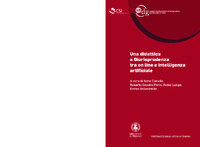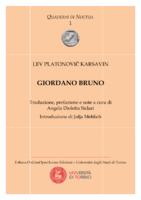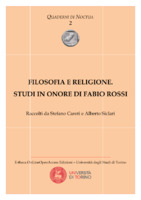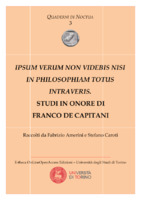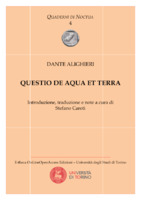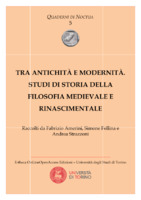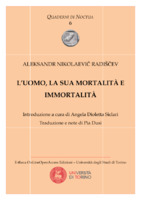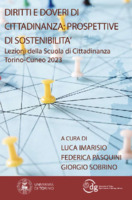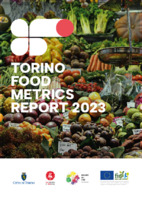Sfoglia documenti (228 in totale)
Sort by:
Una didattica a Giurisprudenza tra on line e intelligenza artificiale
Il Volume presenta il Progetto del Dipartimento di Giurisprudenza di Torino su una didattica universitaria innovativa, cui hanno contribuito, oltre ai docenti di differenti settori scientifici disciplinari, anche il Consorzio Sistemi Informativi del Piemonte, con un team coordinato dalla dott.ssa Anna Cavallo. Un Progetto che ha valorizzato le nuove tecnologie come strumento per la modulazione della didattica universitaria in ragione delle differenti categorie di studenti e studentesse, evidenziando una dimensione intrinsecamente correlata all’attuazione del diritto costituzionalmente tutelato allo studio. Ne è derivata la possibilità di rapportare l’offerta didattica all’andamento medio di studio delle diverse categorie di studenti e studentesse, consentendo una programmazione orientata a garantire ‹‹una didattica differenziata e perciò a ciascuno uguale››.
Giordano Bruno
Il volume comprende la traduzione italiana del Giordano Bruno di Lev Platonovič Karsavin, una prefazione della traduttrice e una introduzione di Julja Mehlich, studiosa di Karsavin. Il testo tradotto fu pubblicato a Berlino nel 1923 e a lungo ignorato dalle ampie bibliografie su Bruno e su Karsavin. Il valore di Bruno, secondo Karsavin, starebbe nel sentimento e nella chiara coscienza della sua unità di spirito con l’Universo divino e con Dio stesso. «L’anima della filosofia del Nolano» è «l’eroico furore», fondamento teorico e pratico dell’unità di vita e di pensiero. Ma in questo Karsavin coglie anche il limite di Bruno: ossia il non aver saputo tener fede all’intuizione secondo la quale l’Assoluto non si identifica mai con la totalità, sia pure infinita, del relativo. L’infinità del Divino è, infatti essenzialmente diversa dall’infinità dell’empirico. In questa confusione Bruno sarebbe l’emblema di tutta l’epoca rinascimentale. Nella sua Introduzione la Mehlich evidenzia nella trattazione di Karsavin il ricorso a un duplice metodo, quello formale dell’individualizzazione, di Heinrich Rickert, e quello fondato sul principio del vseedinstvo (unitotalità), risalente al pensiero di Vladimir Sergeevič Solov’ëv, e ampiamente utilizzato nel pensiero filosofico-religioso russo del Novecento. Peculiarità dell’approccio di Karsavin sarebbe, secondo la studiosa, l’unione dei due piani con la concezione dell’essere storico come personale, e dello sviluppo della storia come storia della persona, della narrazione del suo destino.
The volume includes the Italian translation of Giordano Bruno by Lev Platonovič Karsavin, a preface by the translator and an introduction by Julya Mehlich, a scholar of Karsavin. The translated text was published in Berlin in 1923 and long ignored by the extensive bibliographies on Bruno and Karsavin. Bruno’s value, according to Karsavin, lies in the sentiment and in the clear awareness of his own unity of spirit with the divine Universe and with God himself. “The soul of Nolan’s philosophy” is “heroic fury,” the theoretical and practical foundation of unity of life and thought. But in this Karsavin also grasps Bruno’s limitation: that is, the failure to be able to be faithful to the intuition that the Absolute is never identified with the totality, even if infinite, of the relative. The infinity of the Divine is, in fact, essentially different from the infinity of the empirical. In this confusion, Bruno would be the emblem of the entire Renaissance era. In her Introduction, Mehlich highlights the use of a double method in Karsavin’s treatment: the formal one of individualization, by Heinrich Rickert, and the one based on the principle of vseedinstvo (unitotality), dating back to the thinking of Vladimir Sergeevič Solov’ëv, and widely used in 20th Century’s Russian philosophical-religious thinking. A peculiarity of Karsavin’s approach would be, according to the scholar, the union of the two levels with the conception of the historical being as personal, and the development of history as the history of the person, as narration of his destiny.
The volume includes the Italian translation of Giordano Bruno by Lev Platonovič Karsavin, a preface by the translator and an introduction by Julya Mehlich, a scholar of Karsavin. The translated text was published in Berlin in 1923 and long ignored by the extensive bibliographies on Bruno and Karsavin. Bruno’s value, according to Karsavin, lies in the sentiment and in the clear awareness of his own unity of spirit with the divine Universe and with God himself. “The soul of Nolan’s philosophy” is “heroic fury,” the theoretical and practical foundation of unity of life and thought. But in this Karsavin also grasps Bruno’s limitation: that is, the failure to be able to be faithful to the intuition that the Absolute is never identified with the totality, even if infinite, of the relative. The infinity of the Divine is, in fact, essentially different from the infinity of the empirical. In this confusion, Bruno would be the emblem of the entire Renaissance era. In her Introduction, Mehlich highlights the use of a double method in Karsavin’s treatment: the formal one of individualization, by Heinrich Rickert, and the one based on the principle of vseedinstvo (unitotality), dating back to the thinking of Vladimir Sergeevič Solov’ëv, and widely used in 20th Century’s Russian philosophical-religious thinking. A peculiarity of Karsavin’s approach would be, according to the scholar, the union of the two levels with the conception of the historical being as personal, and the development of history as the history of the person, as narration of his destiny.
Filosofia e religione. Studi in onore di Fabio Rossi
I 14 saggi raccolti in questo volume esplorano i rapporti fra filosofia e religione fra età antica e contemporanea, e lo sviluppo della filosofia della religione a partire dall’età moderna: soffermandosi da una parte sui problemi dell’ateismo, della natura del Cristo, e della teologia razionale di matrice cartesiana, e dall’altra sulle ramificazioni contemporanee della filosofia della religione: nell’ermeneutica, la fenomenologia, e il materialismo storico.
The 14 essays in this volume explore the relationship between philosophy and religion from antiquity to the contemporary age, as well as the development of a philosophy of religion in modern times. It does so by focusing on the topics of atheism, the nature of Christ, and the Cartesian origins of rational theology, on the one hand, and on the contemporary ramifications of philosophy of religion: in hermeneutics, phenomenology, and historical materialism, on the other.
The 14 essays in this volume explore the relationship between philosophy and religion from antiquity to the contemporary age, as well as the development of a philosophy of religion in modern times. It does so by focusing on the topics of atheism, the nature of Christ, and the Cartesian origins of rational theology, on the one hand, and on the contemporary ramifications of philosophy of religion: in hermeneutics, phenomenology, and historical materialism, on the other.
Ipsum verum non videbis nisi in philosophiam totus intraveris. Studi in onore di Franco De Capitani
I 14 saggi raccolti in questo volume esplorano la molteplicità della filosofia agostiniana e della sua ricezione medievale: considerando l’educazione di Agostino e lo sviluppo del suo pensiero veicolato da una serie di immagini e stili filosofici, ne vengono ricostruiti i motivi ricorrenti – la polemica anti-manichea, la visione politica, il ruolo della ragione, la guerra – e la loro fortuna in autori come Tommaso d’Aquino, Nicole Oresme, Gregorio da Rimini, e Roberto Grossatesta.
The 14 essays collected in this volume explore the various aspects of Augustine’s philosophy and its medieval reception: by considering his education and the development of his thought as conveyed by a series of philosophical images and styles, the volume reconstructs the recurring motifs of his intellectual journey (the anti-Manichean polemic, his political vision, the role of reason, and the theory of war) and their fortune in authors such as Thomas Aquinas, Nicole Oresme, Gregory of Rimini, and Robert Grosseteste.
The 14 essays collected in this volume explore the various aspects of Augustine’s philosophy and its medieval reception: by considering his education and the development of his thought as conveyed by a series of philosophical images and styles, the volume reconstructs the recurring motifs of his intellectual journey (the anti-Manichean polemic, his political vision, the role of reason, and the theory of war) and their fortune in authors such as Thomas Aquinas, Nicole Oresme, Gregory of Rimini, and Robert Grosseteste.
Questio de aqua et terra
Il volume presenta una nuova edizione del testo originale e una traduzione italiana della Questio de aqua et terra di Dante Alighieri, discussa a Verona nel 1320. Nell’apparato introduttivo e nel commento al testo, vengono ricostruiti il contesto storico della quaestio alla luce dei dibattiti sulla natura degli elementi e la cosmologia aristotelica, le discussioni storiografiche dell’opera nella storia della scienza e della filosofia, e la fortuna del testo nelle sue edizioni a partire dal XVI secolo.
This volume offers a new edition of the original text and an Italian translation of Dante Alighieri’s Questio de aqua et terra, discussed in Verona in 1320. The introductory apparatus and the textual commentary reconstruct the historical context of the quaestio (in the light of the debates on the nature of the elements and Aristotelian cosmology), its discussions in the historiography of science and philosophy, and the fortune of the text in its editions from the sixteenth century onwards.
This volume offers a new edition of the original text and an Italian translation of Dante Alighieri’s Questio de aqua et terra, discussed in Verona in 1320. The introductory apparatus and the textual commentary reconstruct the historical context of the quaestio (in the light of the debates on the nature of the elements and Aristotelian cosmology), its discussions in the historiography of science and philosophy, and the fortune of the text in its editions from the sixteenth century onwards.
Tra antichità e modernità. Studi di storia della filosofia medievale e rinascimentale
I 26 saggi raccolti in questo volume esplorano aspetti cruciali della tradizione filosofica e scientifica medioevale e rinascimentale: seguendo un approccio storico-filologico, il volume porta alla luce documenti inediti e offre nuove ricostruzioni dei percorsi intellettuali di autori quali Meister Eckhart, Nicole Oresme, Giovanni Buridano, Sigieri di Brabante, Guglielmo di Ockham, Pietro Pomponazzi, e Giovanni Pico della Mirandola.
The 26 essays collected in this volume explore some crucial aspects of the philosophical and scientific traditions of the Middle Ages and the Renaissance. Using a historical-philological approach, the volume brings to light unpublished documents and offers new reconstructions of the intellectual paths of authors such as Meister Eckhart, Nicole Oresme, John Buridan, Siger of Brabant, William of Ockham, Peter Pomponazzi, and Giovanni Pico della Mirandola.
The 26 essays collected in this volume explore some crucial aspects of the philosophical and scientific traditions of the Middle Ages and the Renaissance. Using a historical-philological approach, the volume brings to light unpublished documents and offers new reconstructions of the intellectual paths of authors such as Meister Eckhart, Nicole Oresme, John Buridan, Siger of Brabant, William of Ockham, Peter Pomponazzi, and Giovanni Pico della Mirandola.
L’uomo, la sua mortalità e immortalità
Il volume comprende un ampio saggio introduttivo e la traduzione italiana del trattato Sull’uomo, sulla sua mortalità o immortalità di Aleksandr Nikolaevič Radiščev, scritto in Siberia tra il 1792 e il 1796, pubblicato diversi anni dopo la morte dell’autore. Il trattato inizia con l’esplorazione dei percorsi e dei risultati delle diverse scienze che offrono una conoscenza dei vari aspetti del mondo umano, ma non penetrano la sua essenza. A fondamento del molteplice e del mutevole resta, sconosciuta e indefinibile, la sostanza unica. Dietro il Leibniz dell’epigrafe, dietro Herder e Mendelssohn, si affaccia, non detto, il pericoloso, e forse più amato, Spinoza. Radiščev è una figura emblematica del Settecento Russo, considerato il teorico dell’uguaglianza, e da alcuni critici, a torto, un precursore della rivoluzione russa. Il pensiero di Radiščev a questo proposito è chiaro e matura attraverso le letture del Beccaria, del Filangieri e del Dragonetti: l’uguaglianza di natura (giusnaturalismo) è utopica se non diventa uguaglianza di fronte alla legge.
The volume includes an extensive introductory essay and an Italian translation of the treatise On Man, His Mortality or Immortality by Aleksandr Nikolaevič Radiščev, written in Siberia between 1792 and 1796, published several years after the author’s death. The treatise begins with an exploration of the paths and achievements of the different sciences that offer knowledge of the various aspects of the human world, but do not penetrate its essence. At the foundation of the manifold and the changeable, there remains, unknown and indefinable, the unitary substance. Behind the Leibniz of the epigraph, behind Herder and Mendelssohn, there appears, unspoken, the dangerous, and perhaps most beloved, Spinoza. Radiščev is an emblematic figure of 18th-century Russia, considered the theorist of equality and by some critics, wrongly, a precursor of the Russian Revolution. Radiščev’s thought in this regard is clear and matures through the readings of Beccaria, Filangieri and Dragonetti: equality of nature (natural law) is utopian if it does not become equality before the law.
The volume includes an extensive introductory essay and an Italian translation of the treatise On Man, His Mortality or Immortality by Aleksandr Nikolaevič Radiščev, written in Siberia between 1792 and 1796, published several years after the author’s death. The treatise begins with an exploration of the paths and achievements of the different sciences that offer knowledge of the various aspects of the human world, but do not penetrate its essence. At the foundation of the manifold and the changeable, there remains, unknown and indefinable, the unitary substance. Behind the Leibniz of the epigraph, behind Herder and Mendelssohn, there appears, unspoken, the dangerous, and perhaps most beloved, Spinoza. Radiščev is an emblematic figure of 18th-century Russia, considered the theorist of equality and by some critics, wrongly, a precursor of the Russian Revolution. Radiščev’s thought in this regard is clear and matures through the readings of Beccaria, Filangieri and Dragonetti: equality of nature (natural law) is utopian if it does not become equality before the law.
Diritti e doveri di cittadinanza: prospettive di sostenibilità
Questa pubblicazione rappresenta ormai la quarta tappa di un percorso di riflessione sui diritti e i doveri di cittadinanza, elaborato a partire dalle lezioni della Scuola di Cittadinanza, iniziativa di terza missione organizzata dal Dipartimento di Giurisprudenza dell’Università degli Studi di Torino, nelle sedi di Torino e di Cuneo, a partire dal 2018.
Nell’edizione 2023 della Scuola si è proposto un itinerario di riflessione che, a partire da un inquadramento “di contesto” – il mondo globalizzato e la sua crisi, la complessità dei processi decisionali tra Italia e Unione Europea –, ha esplorato, da prospettive differenti, le implicazioni del principio di “sostenibilità” sui diritti e doveri fondamentali. Ci si è così confrontati coi temi della tenuta dei diritti fondamentali di fronte al dramma della guerra, delle potenzialità e dei limiti dell’impiego degli strumenti del diritto penale in relazione alla sostenibilità ambientale, della sostenibilità delle politiche di contrasto alla fragilità (che chiamano fortemente in causa i rapporti intergenerazionali), della gestione sostenibile delle diversità legate ai convincimenti etico-religiosi.
Con riguardo alla dimensione economica del principio di sostenibilità, si sono poi proposte riflessioni sul principio di sostenibilità intergenerazionale in relazione alle politiche tributarie e di bilancio, così come sulle implicazioni dei principi di sostenibilità e responsabilità nell’impresa e nel contesto lavorativo. Ci si è infine soffermati sul problema della sostenibilità del nostro stesso “modello” di democrazia (anche in relazione ai delicati rapporti tra decisione politica e controllo giurisdizionale), confrontandoci anche con le suggestioni e gli stimoli di “modelli” alternativi, ma animati a loro volta da obiettivi di solidarietà e responsabilità intergenerazionale, come quello legato alla proposta di una “Costituzione per la Terra” di Luigi Ferrajoli.
L’intento complessivo del Volume – pur nell'oggettiva impossibilità di esaurire un tema così controverso ed intricato quale quello delle diverse declinazioni del paradigma della sostenibilità, con riguardo ai diritti e doveri fondamentali – è far emergere, al di là dell’uso divenuto ormai tanto pervasivo quanto sfuggente ed ambiguo dei richiami a tale principio, una rete di implicazioni che, su diversi piani e a partire da diverse prospettive, incidono in misura determinante sul riconoscimento e sulla tutela delle libertà e dei diritti individuali, e rimodulano i correlativi doveri. Con l’ambizione (che anima la Scuola fin dal suo avvio) di proporre riflessioni che, partendo da elementi emergenti nell’attualità del confronto pubblico a livello nazionale e sovranazionale, consentano di fornire stimoli e di contribuire ad arricchire gli strumenti con cui maturare un giudizio più articolato e consapevole in ordine alle principali “questioni” connesse ai diritti e doveri di cittadinanza.
Multilinguisme européen et IA entre droit, traduction et didactique des langues
Multilinguismo europeo e IA tra diritto, traduzione e didattica delle lingue
European Multilingualism and Artificial Intelligence: The Impacts on Law, Translation and Language Teaching
Ce numéro spécial de la revue De Europa recueille les contributions interdisciplinaires et multilingues issues des travaux du groupe de recherche sur les droits et les variations linguistiques en Europe qui ont été entamées depuis 2020 pour le projet Artificial Intelligence for European Integration — AI4EI.
La première partie du livre a permis d’entamer des réflexions sur l’IA et le multilinguisme européen par rapport au droit, par exemple en abordant la question de la traduction juridique automatique ou de la terminologie juridique en relation à l’utilisation de l’IA.
La deuxième partie du livre rassemble des études concernant les expérimentations pédagogiques menées par les universités qui ont participé au projet. À ce sujet, la nécessité de stimuler une posture critique vis-à-vis des nouvelles technologies se révèle fondamentale pour une intégration réussie des dispositifs basés sur l’intelligence artificielle dans la pédagogie universitaire.
Il volume fa parte del progetto AI4EI (https://www.jmcoe.unito.it/)
La première partie du livre a permis d’entamer des réflexions sur l’IA et le multilinguisme européen par rapport au droit, par exemple en abordant la question de la traduction juridique automatique ou de la terminologie juridique en relation à l’utilisation de l’IA.
La deuxième partie du livre rassemble des études concernant les expérimentations pédagogiques menées par les universités qui ont participé au projet. À ce sujet, la nécessité de stimuler une posture critique vis-à-vis des nouvelles technologies se révèle fondamentale pour une intégration réussie des dispositifs basés sur l’intelligence artificielle dans la pédagogie universitaire.
Il volume fa parte del progetto AI4EI (https://www.jmcoe.unito.it/)

